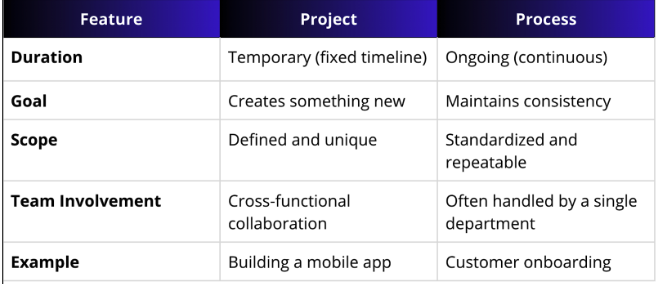Project vs Process: Key Differences in Project Management
How to Know If It Is a Project or a Process for Business Success
Kathleen Moorhed | Project Management Professional
Have you ever planned a vacation? You pick a destination, book your flights, create an itinerary, and then, after an exciting trip, it’s over. That’s a project—a one-time effort with a clear goal and an end date.
Now, think about doing your laundry. You wash, dry, fold, and repeat—week after week. That’s a process—a repeatable workflow that follows the same steps each time to keep things running smoothly.
Projects and processes are part of everyday life, but understanding the difference is especially important in business. In business and project management, understanding the difference between projects vs. processes is essential for improving efficiency, reducing costs, and achieving strategic goals. But how do you know when to run a project versus when to optimize a process?
In this post, we’ll explain the key difference between projects and processes, when to use each, why both are essential and how they work together to create success.
What is a Project?
A project is a temporary effort to achieve a specific goal. It has a clear beginning and end and results in something new—whether it’s a product, service, or improvement.
In project management, a project could look like implementing a new customer relationship management (CRM) system, where teams work together to select software, migrate data, train employees, and ensure a successful launch within a set timeframe and budget.
Key Characteristics of a Project:
Temporary: Projects have a defined start and end date.
Unique Outcome: Each project delivers a specific, one-time result, whether it is a new product, a website launch, or an office relocation.
Defined Scope: A project operates within a clear set of requirements, goals, and constraints.
Requires Cross-functional Effort: Projects often involve multiple teams and departments working together.
Everyday Examples of Projects:
Planning a wedding.
Remodeling a kitchen.
Organizing a charity fundraiser.
Developing a new mobile app.
Implementing a new software system for a company.
Developing a marketing campaign for a product launch.
Constructing a new office building.
Organizing a company-wide training program.
What is a Process?
A process is an ongoing series of repeated steps to keep things running efficiently. Unlike projects, processes do not have an end date—they are part of daily operations.
As a project manager, a process could look like a standardized workflow for onboarding new team members, where each new hire follows the same structured steps—completing paperwork, receiving training, and gaining system access—to ensure a smooth and consistent integration into the team.
Key Characteristics of a Process:
Ongoing and repeatable: It happens over and over again.
Follows a standard procedure: Steps are consistent each time.
Improves efficiency: Well-defined business processes improve operational efficiency and workflow optimization.
Often automated or optimized: Many businesses streamline processes to save time and reduce errors.
Everyday Examples of a Process:
Cooking your favorite recipe every week.
Paying bills every month.
Hiring and onboarding new employees in a company.
Processing customer orders in an online store.
The hiring process for onboarding new employees.
The invoicing process for billing clients.
The customer support process for handling inquiries and complaints.
The procurement process for ordering supplies.
A Projects vs. A Process: Key Differences
Table Depicting Key Differences Between a Project and a Process
How Projects and Processes Work Together
Projects and processes are not opposites—they work hand in hand. Many projects lead to the creation or improvement of a process. For example:
A project to create a customer service manual results in a process for handling complaints.
A project to launch a new website leads to a process for updating content regularly.
A project to improve employee training results in a standard onboarding process.
Successful organizations use projects to innovate and grow while relying on processes to maintain efficiency and consistency.
Final Thoughts
Whether you’re running a business, managing a team, or just organizing your personal life, understanding the difference between projects and processes can help you work smarter.
As a project manager, it's important not just to understand the difference between projects and processes yourself, but to clearly explain that distinction to others—so your team can execute effectively and align their efforts with both operational needs and project goals.
Projects help you achieve big goals, while processes keep things running smoothly. Knowing when to start a project versus when to improve a process can make all the difference in how efficiently you operate.
For a deeper dive into project management best practices, check out our post on becoming a certified project manager.
Paton Consulting helps move people and projects forward! Whether you need expert support in project management, business process improvement, streamlining workflows, or team training—I’d love to help!

